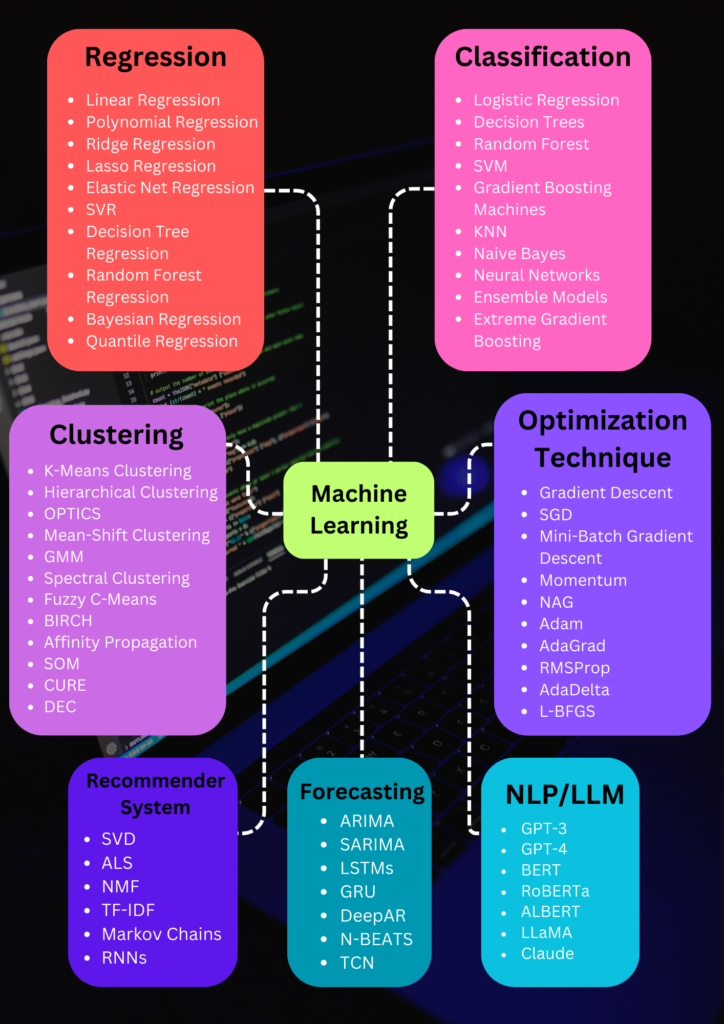Imagine a super-smart robot that can predict the weather, diagnose diseases, or even write a poem. That’s the power of machine learning! But how does this magic happen? Let’s break it down.
What is a Machine Learning Model?
Think of a machine learning model as a super-powered detective who learns from past cases to solve new mysteries. It’s fed a bunch of data (evidence) and then it uses a special algorithm (its detective skills) to find patterns. Once it’s learned enough, it can make predictions or decisions, just like a seasoned detective.
Unlike traditional programming, where rules are explicitly coded, machine learning enables the model to learn rules from data. This adaptability is what makes ML so powerful.
Types of Machine Learning Models

- Supervised Learning: Supervised learning models rely on labeled data—datasets where the outcome (output) is already known. These models aim to learn the relationship between inputs and outputs to make accurate predictions.
- Scenario: You’re teaching a kid to identify animals. You show them pictures of cats and dogs and tell them which is which.
- Model: The model learns from these labeled examples and can then identify new animals.
- Real-world Example: Spam filters that learn to recognize spam emails.
Common Models:
- Linear Regression: Used for predicting continuous outcomes.
- Logistic Regression: Ideal for binary classification problems.
- Support Vector Machines (SVMs): Effective for classification tasks.
- Unsupervised Learning: In unsupervised learning, the data isn’t labeled. The model identifies hidden patterns or groupings in the data without predefined outputs.
- Scenario: You give a kid a box of toys and let them sort them into groups.
- Model: The model finds patterns in the data without any labels.
- Real-world Example: Customer segmentation, where customers are grouped based on their buying behavior.
Common Models:
- Clustering Algorithms (e.g., K-Means, Hierarchical Clustering).
- Dimensionality Reduction Techniques (e.g., Principal Component Analysis or PCA).
- Reinforcement Learning: These models learn by interacting with an environment and receiving feedback in the form of rewards or penalties. Reinforcement learning excels in dynamic environments where actions have long-term consequences.
- Scenario: Training a dog with treats and punishments.
- Model: The model learns by trial and error, getting rewards for good actions and penalties for bad ones.
- Real-world Example: Self-driving cars learning to navigate roads.
Common Models:
- Q-Learning: A value-based method.
- Deep Q Networks: Combines Q-learning with neural networks for complex tasks.
Key Components of Machine Learning Models

- Features: These are the clues the detective uses to solve the case. For example, in predicting house prices, features might include square footage, location, and number of bedrooms.
- Labels: The answer to the mystery. In supervised learning, these are the correct labels for the training data.
- Training Data: The evidence the detective studies. It’s a collection of past cases with known outcomes.
- Evaluation Metrics: How we measure the detective’s success. Metrics like accuracy, precision, and recall help us assess the model’s performance.
- Hyperparameters: The detective’s settings, like how hard they should think or how many clues they should consider.
Breaking Down Popular Models

Here’s a closer look at some widely used machine learning models and their real-world applications:
- Linear Regression
- Purpose: Predict continuous values.
- How It Works: Finds the line of best fit that minimizes the error between predicted and actual values.
- Example: Forecasting sales based on historical trends.
- Decision Trees
- Purpose: Solve classification and regression problems.
- How It Works: Splits data into branches based on feature values, creating a tree-like structure.
- Example: Approving loans based on factors like credit score and income.
- Neural Networks
- Purpose: Handle complex, non-linear patterns in data.
- How It Works: Mimics the human brain using layers of interconnected nodes (neurons).
- Example: Powering facial recognition systems or natural language processing tools.
- K-Means Clustering
- Purpose: Group similar data points into clusters.
- How It Works: Iteratively assigns data points to the nearest cluster center and updates the centers.
- Example: Segmenting customers for targeted marketing campaigns.
Challenges in Building ML Models

Despite their potential, creating effective ML models isn’t straightforward. Common challenges include:
- Data Quality:
Models are only as good as the data they’re trained on. Incomplete, biased, or noisy data can lead to poor performance. - Overfitting:
When a model learns the training data too well, it may struggle to generalize to new data. Techniques like regularization and cross-validation help mitigate this. - Interpretability:
Complex models, especially neural networks, are often seen as “black boxes.” Efforts like explainable AI (XAI) aim to make these models more transparent. - Scalability:
Handling large datasets and deploying models in real-world systems can pose computational and infrastructural challenges.
Why Understanding ML Models Matters
Machine learning isn’t just for data scientists or tech companies—it has implications across industries:
- Healthcare: Diagnosing diseases from medical images or predicting patient outcomes.
- Finance: Detecting fraudulent transactions or optimizing investment strategies.
- Retail: Personalizing customer experiences through recommendation engines.
- Manufacturing: Predicting equipment failures to reduce downtime.
By understanding the basics of machine learning models, professionals from any field can better collaborate with data teams and leverage AI’s potential.
Final Thoughts
Machine learning models may seem complex, but breaking them down into their key components and applications demystifies their functionality. They are powerful tools that enable organizations to make data-driven decisions, solve intricate problems, and drive innovation.
So, the next time you see a recommendation on Netflix or a self-driving car, remember the magic of machine learning behind it. It’s not just a buzzword; it’s the future!